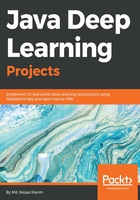
Deep belief networks
To overcome the overfitting problem in MLPs, the DBN was proposed by Hinton et al. It uses a greedy, layer-by-layer, pre-training algorithm to initialize the network weights through probabilistic generative models.
DBNs are composed of a visible layer and multiple layers—hidden units. The top two layers have undirected, symmetric connections in between and form an associative memory, whereas lower layers receive top-down, directed connections from the preceding layer. The building blocks of a DBN are RBMs, as you can see in the following figure, where several RBMs are stacked one after another to form DBNs:

A DBN configured for semi-supervised learning
A single RBM consists of two layers. The first layer is composed of visible neurons, and the second layer consists of hidden neurons. Figure 16 shows the structure of a simple RBM, where the neurons are arranged according to a symmetrical bipartite graph:

RBM architecture
In DBNs, an RBM is trained first with input data, called unsupervised pre-training, and the hidden layer represents the features learned using a greedy learning approach called supervised fine-tuning. Despite numerous successes, DBNs are being replaced by AEs.